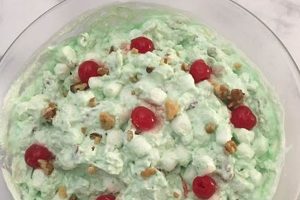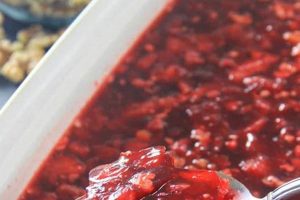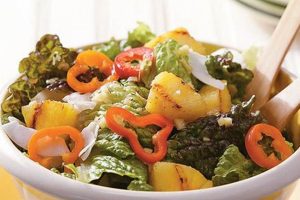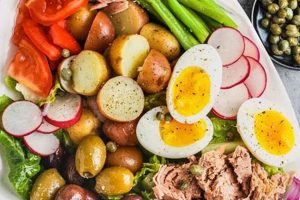Uncooked beet salads offer a vibrant and nutritious way to enjoy this root vegetable. These preparations typically combine thinly sliced or grated beets with complementary ingredients such as fruits, nuts, cheeses, and herbs, all tossed in a flavorful dressing. A simple example might include grated beets, orange segments, crumbled goat cheese, and a citrus vinaigrette.
Maintaining beets in their raw state preserves their delicate texture and maximizes their nutritional value, including essential vitamins, minerals, and antioxidants. Historically, beets have been cultivated for both their roots and greens, and consuming them raw is a relatively modern culinary practice that emphasizes freshness and health benefits. Their earthy flavor and vibrant color make them a welcome addition to a variety of cuisines.
This exploration will delve into various aspects of creating uncooked beet salads, encompassing ingredient selection, preparation techniques, dressing options, and complementary pairings to inspire culinary creativity and healthful eating.
Tips for Preparing Uncooked Beet Salads
Successfully incorporating raw beets into salads requires an understanding of their unique properties. The following tips provide guidance for optimal flavor, texture, and presentation.
Tip 1: Select Fresh, Firm Beets: Choose beets that are firm to the touch with smooth, unblemished skin. Smaller beets tend to be more tender.
Tip 2: Handle with Care: Beet juice can stain hands and clothing. Wearing gloves is recommended during preparation.
Tip 3: Utilize a Mandoline or Sharp Knife: Achieving thin, even slices or gratings ensures a pleasant texture and allows the flavors of the dressing and other ingredients to meld effectively.
Tip 4: Balance the Earthiness: The earthy flavor of beets benefits from balancing elements. Citrus fruits, tangy cheeses, and acidic dressings provide excellent counterpoints.
Tip 5: Incorporate Textural Variety: Combine the beets with contrasting textures, such as crunchy nuts, toasted seeds, or creamy avocado, for a more engaging culinary experience.
Tip 6: Don’t Overdress: Lightly coat the salad with the dressing to avoid overwhelming the delicate flavors and textures.
Tip 7: Allow Flavors to Meld: If time permits, allowing the salad to rest briefly after dressing enhances flavor development.
By following these guidelines, one can create uncooked beet salads that are both visually appealing and nutritionally rewarding, maximizing the unique characteristics of this versatile root vegetable.
Incorporating these techniques elevates the simple beet salad to a sophisticated and healthful culinary creation.
1. Ingredient Selection
Ingredient selection significantly impacts the flavor profile, nutritional value, and overall appeal of uncooked beet salads. Careful consideration of each component ensures a balanced and enjoyable culinary experience. Beets, while central, offer a foundational element upon which a diverse array of complementary flavors and textures can be built. The inherent earthiness of beets necessitates thoughtful pairings to achieve optimal balance. For instance, the sharpness of goat cheese or feta tempers the beet’s sweetness, while the acidity of citrus fruits, such as oranges or grapefruit, brightens the overall composition. Toasted walnuts or pecans introduce a textural contrast and complementary richness, while fresh herbs like dill or mint contribute aromatic complexity.
Beyond flavor and texture, ingredient selection also affects nutritional value. Combining beets with nutrient-rich greens like spinach or arugula amplifies the vitamin and mineral content. Adding antioxidant-rich components such as berries or pomegranate seeds further enhances the health benefits. Understanding these synergistic relationships allows for the creation of salads that are both delicious and nutritionally dense. The choice of dressing also plays a crucial role; a light vinaigrette with a citrus or vinegar base enhances the natural flavors without masking the delicate nuances of the other components. Overly rich or heavy dressings can detract from the freshness and vibrancy of a raw beet salad.
Successful ingredient selection hinges on a balance of flavor, texture, and nutritional considerations. A well-composed raw beet salad offers a complex interplay of sweet, savory, tangy, and earthy notes, underscored by a variety of textures and enhanced by a nutritionally robust profile. This awareness empowers informed choices that elevate the simple beet salad from a basic dish to a culinary creation that delights the palate while promoting well-being.
2. Preparation Techniques
Preparation techniques significantly influence the final quality and sensory experience of uncooked beet salads. These techniques affect not only the texture and presentation but also how the flavors meld and the overall nutritional value is preserved. Consider the difference between coarsely chopped beets and thinly shaved beets: the former offers a more substantial bite, while the latter provides a delicate texture and allows for greater absorption of the dressing. Similarly, the choice between grating and julienning alters the mouthfeel and visual appeal. These seemingly subtle differences can dramatically impact the overall enjoyment of the salad.
Beyond slicing and grating, other preparation techniques contribute to the overall success of these salads. Proper washing and handling are crucial for both food safety and maintaining the beet’s vibrant color. Soaking sliced beets in ice water can help maintain crispness and reduce staining of other ingredients. Furthermore, the order of operations matters. Dressing the salad too far in advance can lead to wilting and a loss of texture. Conversely, adding certain ingredients, such as toasted nuts, just before serving preserves their crunch and prevents them from becoming soggy. Understanding these nuances allows for precise control over the final product, ensuring a salad that is both visually appealing and texturally satisfying.
Mastery of preparation techniques elevates the uncooked beet salad from a simple dish to a culinary expression. Careful attention to detail, from the initial washing and slicing to the final assembly, maximizes the potential of this versatile root vegetable. This knowledge empowers culinary exploration and ensures a consistently delightful and nutritious dining experience. The understanding of appropriate preparation techniques allows one to not only enhance the sensory characteristics of the salad but also to preserve the nutritional integrity of its components.
3. Flavor Balancing
Flavor balancing is paramount in raw beet salad recipes due to the beet’s inherent earthiness, which can dominate if not properly addressed. A successful salad hinges on a harmonious interplay of flavors that complement and enhance, rather than mask, the beet’s distinctive taste. This involves strategic selection and proportioning of ingredients to create a balanced sensory experience.
- Acidity as a Counterpoint
Acidity plays a crucial role in tempering the beet’s earthy sweetness. Ingredients like citrus fruits (orange, grapefruit, lemon), vinegars (balsamic, apple cider, red wine), and acidic cheeses (goat cheese, feta) provide a sharp counterpoint that brightens the overall flavor profile. For instance, a blood orange vinaigrette adds a tangy sweetness that complements the beet while contributing a vibrant color dimension. The judicious use of acidity prevents the salad from becoming overly sweet or one-dimensional.
- Textural Nuances and Flavor Dynamics
Textural contrast adds another layer of complexity to flavor balancing. Crunchy elements like toasted nuts (walnuts, pecans, hazelnuts), seeds (pumpkin, sunflower), or croutons introduce a textural counterpoint to the beet’s smoothness. This interplay of textures enhances the overall sensory experience. For example, the bitterness of toasted walnuts offsets the beet’s sweetness, while the crunch provides a pleasing contrast to the beet’s tender texture. This multi-sensory approach elevates the salad beyond a simple combination of ingredients.
- Herbaceous and Aromatic Accents
Fresh herbs and aromatic spices can significantly influence the flavor profile. Dill, mint, parsley, and chives introduce herbaceous notes that complement the beet’s earthiness. Spices like ginger or cumin add warmth and complexity. A sprinkle of fresh dill brightens the salad with its slightly tangy, anise-like flavor, while a pinch of ground cumin adds a warm, earthy note that complements the beet without overwhelming it. The strategic use of herbs and spices adds depth and nuance to the overall flavor composition.
- Sweetness as a Balancing Element
While beets possess inherent sweetness, incorporating other sweet elements can further enhance flavor balance, particularly when paired with acidic components. Fruits like berries (strawberries, raspberries, blueberries) or dried fruits (cranberries, raisins) introduce a nuanced sweetness that complements the beet’s earthiness. A handful of dried cranberries adds a chewy texture and tart-sweet flavor that balances the beet’s earthiness and the vinaigrette’s acidity. This interplay of sweet, sour, and earthy notes creates a more complex and satisfying flavor profile.
The interplay of these flavor balancing elements is essential for creating a successful raw beet salad. The goal is not to mask the beet’s unique flavor but to enhance and elevate it through strategic pairings and thoughtful proportions. A well-balanced salad offers a complex interplay of flavors and textures that delight the palate while showcasing the versatility of this remarkable root vegetable.
4. Textural Contrast
Textural contrast plays a crucial role in elevating raw beet salads from simple to sophisticated culinary experiences. The inherent smoothness of raw beets, whether grated or thinly sliced, benefits significantly from the incorporation of contrasting textures. This interplay not only enhances the sensory experience but also adds visual appeal and encourages more thorough mastication, potentially aiding digestion and nutrient absorption.
Consider the addition of toasted nuts. Walnuts, pecans, or hazelnuts provide a satisfying crunch that offsets the beet’s smoothness. This contrast stimulates the palate and prevents the salad from feeling monotonous. Similarly, incorporating seeds, such as toasted sunflower or pumpkin seeds, adds a delicate crispness alongside a nutritional boost. Croutons, whether store-bought or homemade, offer another avenue for textural variation, introducing a satisfying bite that complements the other ingredients. Even incorporating crunchy vegetables, like thinly sliced fennel or shredded carrots, can create a dynamic textural landscape within the salad.
Beyond these common additions, more creative options exist. Crispy fried onions or shallots offer a pungent flavor and a brittle texture that contrasts sharply with the beet’s earthiness. Crumbled feta or goat cheese contributes a creamy texture that plays against the crunch of nuts and seeds. Even the inclusion of chewy dried fruits, such as cranberries or golden raisins, can add a textural dimension often overlooked in salad preparation. The strategic combination of these elements transforms the salad into a multi-sensory experience, where each bite offers a unique and satisfying interplay of textures that complements the complex flavor profile of a well-composed raw beet salad. Careful consideration of textural contrast demonstrates an attention to detail that elevates the dish and highlights the culinary potential of this versatile root vegetable.
5. Dressing Choices
Dressing choices profoundly influence the overall flavor profile and balance of raw beet salads. The dressing acts as a unifying element, binding the ingredients together while contributing its own distinct character. A well-chosen dressing complements the earthiness of beets and harmonizes with the other components, creating a cohesive and flavorful experience. Conversely, an ill-suited dressing can overwhelm the delicate flavors of the salad or clash with its inherent sweetness and earthiness. Therefore, careful consideration of dressing options is essential for achieving a successful and satisfying culinary outcome.
- Acidity and Brightness
Acidic dressings provide a necessary counterpoint to the beet’s earthy sweetness. Vinegars, such as balsamic, apple cider, or red wine vinegar, offer varying levels of sharpness and complexity. Citrus juices, like lemon or orange, contribute brightness and a touch of sweetness. A balsamic vinaigrette with a touch of Dijon mustard adds a tangy complexity that complements the beet’s earthiness, while a lemon vinaigrette provides a refreshing lift. The acidity also helps to balance the richness of any added nuts or cheeses.
- Oil and Texture
The choice of oil influences both the flavor and texture of the dressing. Extra virgin olive oil offers a robust flavor that pairs well with beets, while lighter oils like grapeseed or avocado oil provide a more neutral base. The oil also contributes to the dressing’s texture, creating a smooth and emulsified consistency that coats the salad ingredients evenly. A walnut oil-based dressing adds a nutty richness that complements both beets and walnuts, while a lighter grapeseed oil allows the other flavors to shine through.
- Sweet and Savory Balance
Balancing sweet and savory elements in the dressing further enhances the complexity of the salad. A touch of honey or maple syrup can complement the beet’s natural sweetness, while the addition of savory components like Dijon mustard or minced garlic adds depth and dimension. A honey-mustard vinaigrette balances sweet and savory notes, creating a dynamic flavor profile that complements a variety of ingredients. The interplay of these flavors creates a more nuanced and satisfying experience.
- Herbaceous and Aromatic Infusions
Fresh herbs and spices can elevate the dressing from simple to sophisticated. Minced fresh herbs, such as dill, parsley, or chives, add brightness and aromatic complexity. Incorporating spices like cumin or coriander introduces warm, earthy notes that complement the beet’s inherent flavor. A dill and lemon vinaigrette adds a refreshing herbal note, while a cumin-lime vinaigrette introduces a touch of spice and zest. These additions create a more layered and nuanced flavor profile.
The selection of a dressing for a raw beet salad is not merely a functional choice but an opportunity to enhance and elevate the dish. A well-crafted dressing complements the beet’s earthiness, balances its sweetness, and harmonizes with the other ingredients, creating a cohesive and flavorful culinary experience. By carefully considering the interplay of acidity, oil, sweetness, and aromatics, one can create a dressing that transforms a simple beet salad into a truly memorable dish.
6. Presentation
Presentation significantly impacts the perceived value and enjoyment of raw beet salads. While flavor and nutrition remain paramount, visual appeal enhances the dining experience, stimulating appetite and creating a sense of anticipation. Thoughtful presentation elevates the salad from a simple dish to a culinary creation, showcasing the vibrant colors and textures of the ingredients.
- Color and Contrast
The vibrant hues of beets offer a striking foundation for visual composition. Deep red and golden beets provide inherent color contrast, further enhanced by the inclusion of complementary ingredients. The verdant green of fresh herbs, the bright orange of citrus segments, or the creamy white of goat cheese create a visually dynamic and appealing presentation. This interplay of colors stimulates the senses and enhances the overall dining experience.
- Plating Techniques
Strategic plating techniques showcase the individual components while creating a cohesive presentation. Consider arranging the beet slices or gratings artfully on the plate, rather than simply piling them in a bowl. This allows the vibrant colors to shine and creates visual interest. Incorporating height and layering adds dimension to the presentation. A mound of salad greens topped with thinly sliced beets and crumbled cheese creates a visually appealing structure. The use of appropriate plating techniques demonstrates attention to detail and elevates the perceived value of the dish.
- Garnishes and Finishing Touches
Garnishes provide the final flourish, adding visual appeal and subtle flavor nuances. A sprinkle of chopped fresh herbs, a drizzle of balsamic glaze, or a scattering of toasted nuts elevates the presentation and enhances the sensory experience. These finishing touches demonstrate care and attention, transforming a simple salad into a more refined culinary creation. A sprig of fresh dill adds a pop of color and a delicate anise flavor, while a drizzle of balsamic glaze provides a touch of sweetness and visual contrast. These seemingly small details contribute significantly to the overall impression.
- Serving Vessels
The choice of serving vessel further influences the presentation. A shallow bowl showcases the vibrant colors and textures, while a taller glass allows for layering and creates a more dramatic presentation. The shape and material of the vessel should complement the style of the salad. A rustic wooden bowl enhances the natural aesthetic of a beet salad with earthy ingredients, while a sleek white plate provides a modern backdrop for a more minimalist presentation. The serving vessel acts as a frame, enhancing the visual appeal of the salad.
The presentation of a raw beet salad is an opportunity to enhance its inherent beauty and create a more engaging dining experience. By considering color contrast, plating techniques, garnishes, and serving vessels, one can elevate this simple dish to a visually stunning and truly memorable culinary creation. These elements, combined with the vibrant flavors and nutritional benefits of raw beets, create a holistic and satisfying culinary experience.
7. Nutritional Benefits
Raw beet salads offer a potent delivery system for a range of essential nutrients, often exceeding the nutritional contribution of cooked preparations. Heat can degrade certain vitamins and minerals, making raw consumption a preferred method for maximizing nutritional intake. Beets are particularly rich in nitrates, which the body converts to nitric oxide. Nitric oxide plays a crucial role in vasodilation, potentially contributing to improved blood flow and lower blood pressure. This benefit is particularly relevant for individuals seeking natural ways to support cardiovascular health. Furthermore, raw beets provide a good source of folate, a B vitamin essential for cell growth and development, and manganese, a mineral crucial for bone health and metabolic function. The fiber content in raw beets supports digestive health and can contribute to feelings of satiety, potentially aiding in weight management. A typical raw beet salad, incorporating other nutrient-rich ingredients like leafy greens and nuts, further amplifies these health benefits. For example, combining beets with spinach and walnuts creates a salad rich in nitrates, folate, vitamin K, and omega-3 fatty acids.
The nutritional advantages of raw beets extend beyond individual nutrients. Beets contain betalains, potent antioxidants that combat oxidative stress and inflammation within the body. These antioxidants contribute to overall cellular health and may play a role in reducing the risk of chronic diseases. The fiber in raw beets supports a healthy gut microbiome, crucial for immune function and nutrient absorption. This combination of vitamins, minerals, antioxidants, and fiber makes raw beet salad a nutritionally dense meal option. Furthermore, the natural sugars in beets provide a sustained energy source, unlike refined sugars that can lead to energy spikes and crashes. This makes raw beet salad a suitable option for individuals seeking sustained energy levels throughout the day. For athletes, the nitrates in beets can potentially improve exercise performance by enhancing blood flow and oxygen delivery to muscles. A study published in the Journal of the Academy of Nutrition and Dietetics demonstrated improved running performance in athletes who consumed beet juice prior to exercise.
Incorporating raw beet salads into one’s diet offers a practical and palatable approach to enhancing nutritional intake and supporting overall well-being. While individual results may vary, the scientific evidence supporting the health benefits of beets, particularly when consumed raw, is compelling. Challenges to regular consumption may include the earthy flavor of beets or concerns about staining. However, these challenges can be addressed through appropriate flavor pairings, such as citrus fruits and tangy cheeses, and careful handling techniques. Ultimately, the nutritional advantages of raw beet salads, combined with their culinary versatility, make them a valuable addition to a health-conscious diet.
Frequently Asked Questions
This section addresses common inquiries regarding the preparation and consumption of uncooked beet salads, providing clear and concise information to facilitate successful culinary experiences and address potential concerns.
Question 1: How can beet staining be minimized during preparation?
Wearing gloves while handling beets is recommended. Additionally, soaking peeled and sliced beets in ice water for a short period can help reduce staining. A dedicated cutting board can also prevent staining of other surfaces.
Question 2: Can all beet varieties be consumed raw?
While most beet varieties are suitable for raw consumption, smaller, younger beets tend to be more tender and less earthy. Chioggia beets, with their distinctive candy-cane stripes, offer a milder flavor and visually appealing presentation in raw salads.
Question 3: How long can a raw beet salad be stored?
For optimal quality and food safety, it is recommended to consume raw beet salads within two days of preparation. Store the salad in an airtight container in the refrigerator, keeping the dressing separate until just before serving to prevent wilting and maintain texture.
Question 4: What are the best methods for slicing or grating raw beets?
A mandoline slicer provides uniform, thin slices ideal for salads. Alternatively, a sharp knife can be used with careful attention to consistent thickness. For grating, a box grater or food processor with a grating attachment yields satisfactory results. The desired texture will dictate the appropriate method.
Question 5: Can the beet greens be incorporated into the salad?
Beet greens are edible and offer nutritional value. Younger, tender greens can be added raw to the salad, while more mature greens may benefit from light steaming or sauting before incorporation.
Question 6: How can the earthy flavor of beets be balanced in a salad?
The earthiness of beets is often balanced with acidic ingredients, such as citrus fruits or vinegars. Tangy cheeses, like goat cheese or feta, also provide a complementary contrast. Sweet elements, such as fruits or a touch of honey in the dressing, can further enhance the flavor profile by creating a balanced interplay of sweet, sour, and earthy notes.
Understanding these common considerations facilitates successful preparation and enjoyable consumption of raw beet salads, maximizing both their nutritional and culinary potential.
This concludes the frequently asked questions section. The following section will offer a collection of curated raw beet salad recipes.
Conclusion
Exploration of uncooked beet salad preparation reveals a dish offering both vibrant flavor and significant nutritional value. Careful ingredient selection, utilizing contrasting textures and flavors, and understanding the importance of proper preparation techniques are crucial for maximizing the culinary potential of this versatile root vegetable. Balancing the beet’s inherent earthiness with acidic elements, incorporating textural variety through nuts and seeds, and selecting a complementary dressing are key considerations for a successful outcome. Furthermore, attention to presentation elevates the dining experience, transforming a simple salad into a visually appealing culinary creation. The nutritional benefits of consuming beets raw, including their rich nitrate, folate, and antioxidant content, further underscore the value of incorporating these salads into a health-conscious diet.
Culinary experimentation with uncooked beet salads offers a pathway to both healthful eating and gastronomic exploration. Further investigation into specific flavor profiles, regional variations, and innovative ingredient combinations promises continued evolution and appreciation of this versatile and nutritious dish. The potential for culinary creativity within this realm remains vast, offering opportunities for ongoing discovery and enjoyment.






